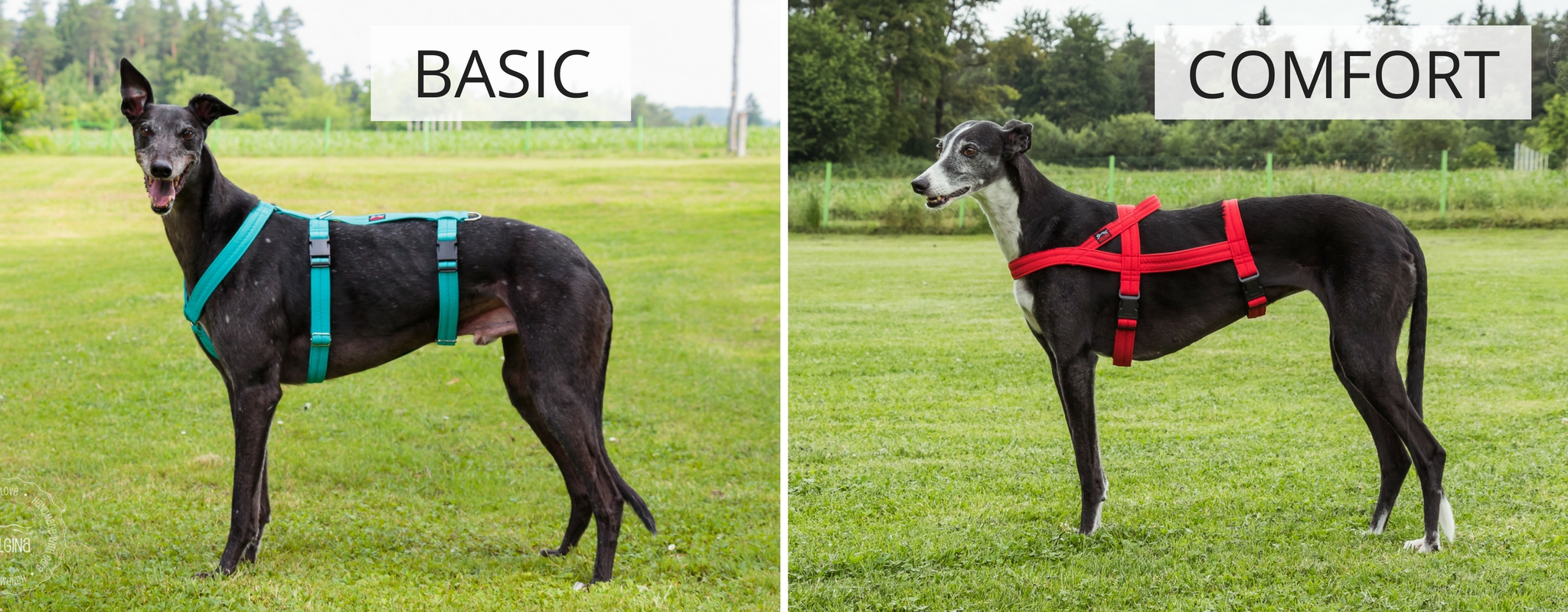Comparison of Basic and Comfort harness models

We often receive questions about the differences between the harness models that are on our offer and which of them is “better”. Each has its own advantages and disadvantages, but because the needs and opinions differ, the decision for a particular model is rather individual. In order to make it easier to decide which model you are more inclined to choose, we have put some words on this topic.
Purpose
Both models, Basic and Comfort, are designed for dog walking. They are not intended for pulling (not even as a sports discipline) nor for safety attaching to a seat belt in a car (in case of a car accident).
Safety
In terms of safety, the models do not differ from one another. Both have an added ribbon that grasps the sighthound on the narrowest part of the body, which (when the harness is put on correctly) prevents the sighthound from escaping.
Basic harness
The basic harness imitates the most standard and most common harness model. This style is most often recommended by dog training experts, mainly because all strips as much as possible avoid the joints of the forelegs.
With the Basic model, you can adjust the length of more strips: both strips on the neck and both strips that embrace the chest.
The leash can be attached to two different points on the back, behind the shoulder blades or at the end of the thorax.
In practice, the Basic harness turns out to be a bit more demanding to put on. First, you put the unfastened harness over the dog’s head, insert one front leg through the opening, pull the straps under the belly, and fasten the two clips.
The Basic harness has two metal rings (strip junction). One is at the front of the thorax on the sternum, and the other on the withers. The front metal ring can sometimes rub the dogs, especially if they are really skinny. As far as we observed this situation, it is always associated with constant pulling on the leash and does not occur in dogs that walk on a loose leash.
The Basic harness tends to rotate/move towards one or the other side of the body, with the lower underbelly strap moving into one or the other armpit. This happens due to the length of the harness (it is longer than the harnesses for other dogs) and because the sighthounds have an extremely narrow body, some of them also have a very exposed spine. The phenomenon is more pronounced in energetic dogs, those who leap from side to side a lot, and less in those who walk calmly on a loose leash. Most dogs (or owners) are not bothered by this harness movement, but some of them are sensitive to it after all. Twisting can be mitigated by adjusting the strips (so they are tight enough), with double-sided buckles, and of course by walking on a loose leash; otherwise, it occurs with all manufacturers of such harness style.
Comfort harness
A comfort harness is slightly more pleasant for putting on. You simply place the unfastened harness over the head, pull the straps under the belly and fasten them. For dogs who really do not like touching and lifting their legs (mentally ruined, elderly, injured) this can be some kind of relief.
With the Comfort model, only two strips can be adjusted in length, the ones that embrace the chest.
A Comfort harness is more stable on the dog and is less inclined to side movements. There is no underwear belt, so rubbing in the armpit area is avoided which is more comfortable for dogs that are sensitive to it. There is also no back strip that runs above the spine.
The leash can only be attached to one point, the mounting ring is freely inserted into the “handle” and can be moved without even pulling along the entire harness. Some people also use this “handle” when they want to hold the dog closer to themselves or to achieve better control over the dog.
The comfort harness does not have metal junction rings, so they can’t rub the dog. Nevertheless, the front strip can still rub the dog if he tows and pulls the leash a lot.
Width
Both models are available in two versions, the strips can be 2.5 cm wide or 3.3 cm wide. The difference between both widths is evident and the harness with wider straps is much more massive than the narrower one. In the case of wider strips, buckles are also larger, as are the metal rings in the larger Basic harness.
In general, most whippet owners, podenco and slender galgo, saluki owners choose the narrower width. Almost without exception, owners of average-sized galgos and greyhounds go for a wider version. Of course, the width choice depends solely on the personal taste of the owners.
Size
Both models are made to order and upon given measurements. Often, owners worry about the harness becoming too small or too big if the dog will lose or gain some weight. Concerns are unneeded because a few kg does not significantly affect the dimensions and you have enough room for maneuver.
Of course, things are a bit different with puppies. If you do not want to replace the harness before they grow up, we recommend you order the harness at the age of at least 6-8 months for whippets and at least 8-10 months for galgos/greyhounds.
Use/use in training
Harnesses are strongly recommended by dog training experts, as they, in contrast to the collar, avoid lymph nodes, veins, and other anatomical structures, which should be avoided when the equipment is as kind to the dogs as it can be. That’s why a harness is a common choice of the owners whose dogs constantly pull and tow the leash, as they want to avoid possible unpleasant consequences caused by long-term leash pulling.
It should be noted, however, that the harness itself does not act as a miracle piece of equipment, and the dog will not stop unwanted behavior because of it. This kind of training requires quite a lot of effort, therefore harness is not a solution, but it is certainly also welcome in the process of loose-leash training.
For more information, please contact us by e-mail at [email protected]





